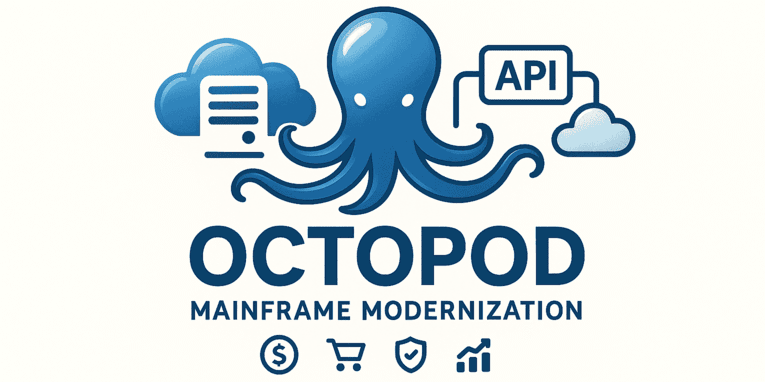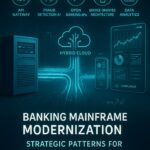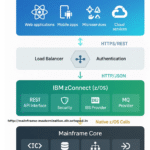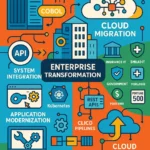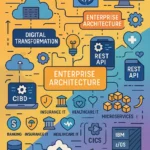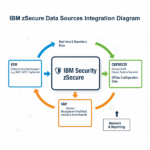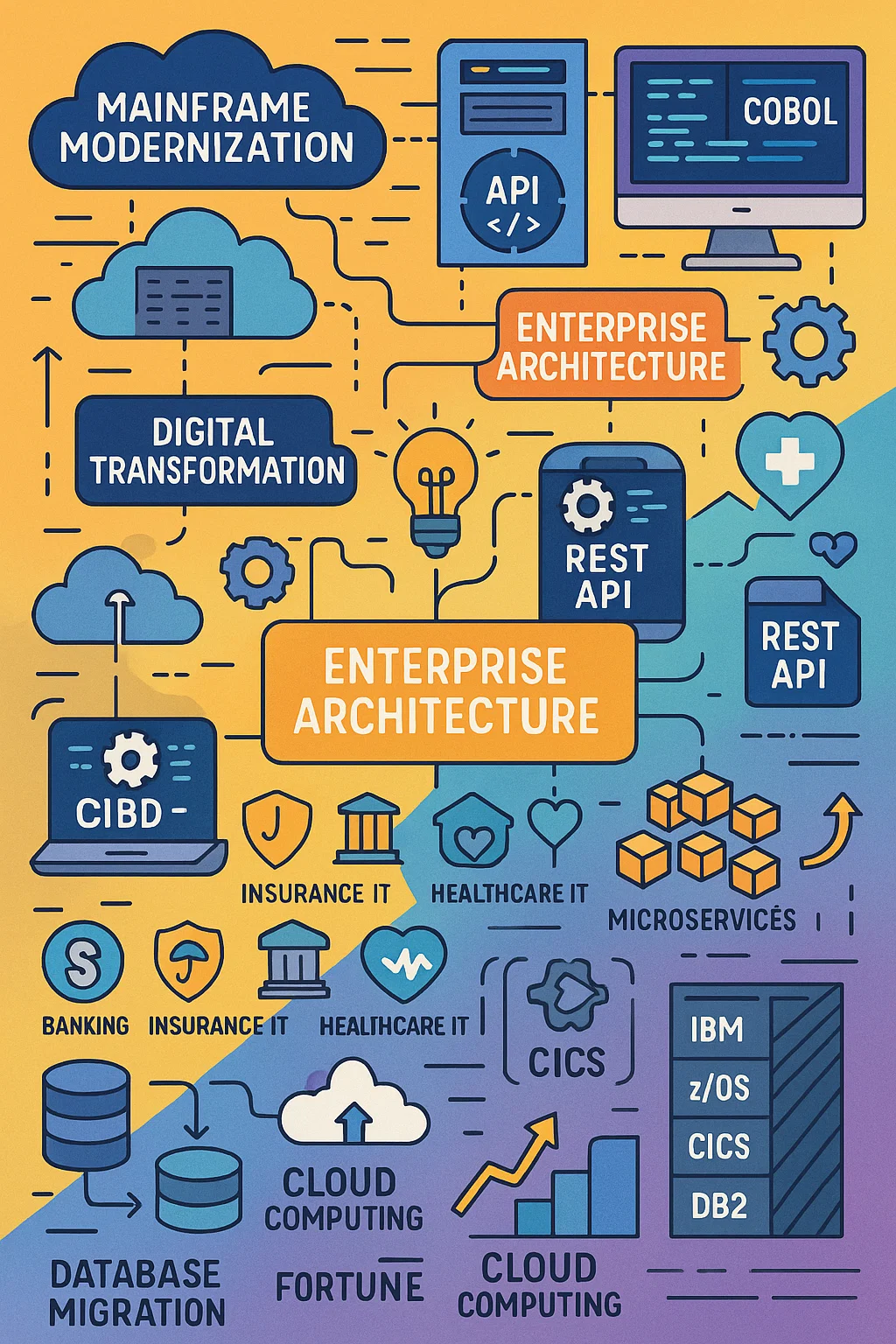Mainframe Observability Revolution: Navigating the Evolving Vendor Landscape in the OpenTelemetry Era
The enterprise IT landscape is experiencing a seismic shift as organizations grapple with increasing complexity across hybrid infrastructures, cloud-native applications, and legacy mainframe systems. With 81% of surveyed executives believing that reducing IT complexity creates competitive advantage, choosing the right observability platform has become mission-critical. What’s changed the game entirely is the emergence of OpenTelemetry as the bridge between mainframe and modern observability ecosystems.
This analysis examines the evolving mainframe observability landscape, where traditional vendors are adapting to modern requirements while new integration patterns emerge. Rather than declaring winners and losers, we’ll explore how different approaches serve varying enterprise needs in this complex ecosystem.
The OpenTelemetry Mainframe Revolution
The OpenTelemetry project and The Open Mainframe Project established the Special Interest Group (SIG) “OpenTelemetry on Mainframe” at the beginning of 2024, focusing on enabling OpenTelemetry on the mainframe for improved end-to-end observability and supporting mainframe participation in hybrid cloud applications.
This development represents a paradigm shift. For decades, mainframe observability existed in isolation, using proprietary protocols and tools. With OpenTelemetry Collector release v0.86.0, precompiled binaries and container images are now provided for linux/s390x as part of the regular release cycle, finally bridging the gap between mainframe and modern observability ecosystems.
The Diverse Mainframe Observability Vendor Landscape
IBM’s Z-Native Ecosystem: Deep Platform Integration
The OMEGAMON Foundation: The OMEGAMON products are a suite of products used to monitor and manage sophisticated mainframe applications and environments, sharing a common technology, Tivoli Management Services on z/OS. This represents decades of Z platform evolution and intimate hardware-software integration.
IBM’s Comprehensive Z Observability Portfolio:
- OMEGAMON AI Suite: IBM Z OMEGAMON AI for z/OS lets you monitor and manage workload performance, resource utilization of entire sysplexes, and the individual z/OS systems that participate in them
- Application-Specific Monitoring: IBM OMEGAMON for IMS on z/OS provides alerts, finds root-cause issues and takes corrective actions, while IBM OMEGAMON for Db2 Performance Expert offers single-tool monitoring for database performance
- Modern Integration: IBM Z Integration for Observability diagnoses system issues by correlating events from OMEGAMON and multiple data sources across hybrid topologies
Z Application Performance Management Connect: IBM Z Application Performance Management Connect provides transaction tracking information from z/OS subsystems to APM solutions, enabling OpenTelemetry integration while leveraging IBM’s unique hardware-level access.
BMC’s Expanded Mainframe Portfolio: The Compuware Integration
BMC has acquired Compuware, indicating that consolidation in the mainframe software market is not over. The two companies believe the newly combined portfolio will help IT organizations more easily transition their legacy applications over to the cloud-based DevOps world.
BMC’s Comprehensive Mainframe Observability Suite:
Traditional BMC AMI (Automated Mainframe Intelligence):
- BMC AMI Ops: Real-time mainframe performance monitoring with AI-powered anomaly detection
- BMC AMI DevX: Code debugging and development acceleration with conversational AI
- BMC Helix Observability: 360-degree environment visibility with AIOps capabilities
Acquired Compuware Portfolio:
- BMC Compuware Topaz is a modern Agile platform of mainframe development and testing tools that integrates into your DevOps toolchain, empowering any developer, regardless of experience, to understand and work on any program, no matter how old or complex
- BMC integrated the BMC Compuware ISPW CI/CD platform with Git repositories to accelerate bringing DevOps best practices to the mainframe
- BMC Compuware Topaz Connect bridges the IT systems that manage mainframe applications with the modern tooling used to manage non-mainframe applications
Integrated Observability Approach: The strategic combination builds on the success of BMC AMI and Compuware’s Topaz suite, ISPW technology, and classic product portfolios to modernize clients’ mainframe environments, enabling automation and intelligent operations with agile development and delivery
Broadcom (formerly CA): Enterprise-Scale Observability
Operations management solutions from Broadcom provide end-to-end visibility and in-depth diagnostics to help you improve customer experience and operational efficiency.
Broadcom’s WatchTower Observability Platform: Today’s mainframe observability solutions must expand mainframe observability to multi-platform, enterprise-wide tools so that SREs can zero in on and fix critical alerts.
Key Broadcom Capabilities:
- Multi-Platform Integration: Broadcom is helping customers embrace open tools and technologies, integrate their Mainframe as part of their cloud and create new innovation opportunities that drive business forward
- Enterprise Licensing Models: Comprehensive mainframe portfolio with enterprise-focused licensing strategies
- Legacy CA Heritage: Decades of mainframe operations management expertise
Rocket Software: Application-Centric Modernization
Rocket Software offers a variety of products that provide critical mainframe modernization and infrastructure solutions for organizations around the world.
Rocket’s Mainframe Observability Focus: Rocket Software survey finds only 28% are highly confident in addressing mainframe vulnerabilities. Choose Rocket Software for unmatched protection against rising cyber threats with hybrid cloud solutions built to meet evolving market needs — in any environment
Application-Centric Approach:
- Focus on mainframe application observability and optimization
- Security-first approach to mainframe monitoring
- Hybrid cloud integration capabilities
OpenTelemetry Integration Patterns Across Vendors
IBM’s Hardware-Intimate Approach
Deep System Integration: IBM’s Z-native advantage allows access to system internals that external tools cannot reach:
- Hardware-level performance counters
- z/OS kernel-level instrumentation
- Real-time system resource management data
- Specialty processor utilization metrics
OpenTelemetry Implementation: IBM Instana enhances OpenTelemetry by seamlessly integrating with the OpenTelemetry Collector, ensuring comprehensive monitoring for cloud-native applications while maintaining deep mainframe integration.
BMC’s DevOps-First Strategy
Modern Development Integration: BMC’s approach focuses on making mainframe development accessible to modern DevOps teams:
- Git integration for mainframe source code management
- CI/CD pipeline integration through ISPW
- Developer-friendly interfaces for complex mainframe operations
OpenTelemetry Utilization: BMC Helix AIOps connects with OpenTelemetry to help site reliability engineers solve application errors, with BMC Helix OpenTelemetry dashboards allowing organizations to track and analyze trace data of services constituting applications.
Broadcom’s Enterprise Integration Focus
Multi-Platform Observability: Broadcom emphasizes enterprise-wide visibility that includes but extends beyond mainframes:
- Cross-platform correlation capabilities
- Enterprise-scale data processing
- Comprehensive operational management
Rocket Software’s Security-Centric Monitoring
Application Security Integration: Rocket’s approach prioritizes security observability within mainframe environments:
- Vulnerability assessment integration
- Threat detection capabilities
- Compliance-focused monitoring
Third-Party Platform Integration: Universal Connectivity
Datadog Integration Patterns
Different Vendor Approaches:
- IBM: Native OTLP support with deep system-level metrics and hardware performance correlation
- BMC: Application-focused telemetry through OpenTelemetry Collector with development workflow integration
- Broadcom: Enterprise-scale metric streaming with multi-platform correlation
- Rocket: Security-focused telemetry with threat detection integration
Splunk Integration Strategies
Varied Implementation Models:
- IBM: Direct OTLP streaming with comprehensive system event correlation
- BMC: DevOps-oriented telemetry with CI/CD pipeline integration
- Broadcom: Enterprise log management with operational workflow integration
- Rocket: Security event correlation with compliance reporting
ELK Stack Connectivity
Diverse Data Flows:
- IBM: Rich system logs with performance metrics through native Elasticsearch integration
- BMC: Structured application telemetry with developer-friendly visualization
- Broadcom: Enterprise-scale log processing with operational correlation
- Rocket: Security-focused log analysis with threat intelligence integration
Nagios Integration Approaches
Alert Management Strategies:
- IBM: System-level alerting with deep diagnostic context and automated remediation
- BMC: Application-focused alerting integrated with modern operational workflows
- Broadcom: Enterprise alert correlation with multi-platform incident management
- Rocket: Security-centric alerting with vulnerability management integration
Comparative Analysis: Strengths and Trade-offs
Deep Technical Capabilities
| Capability | IBM Z-Native | BMC+Compuware | Broadcom | Rocket Software |
|---|---|---|---|---|
| Hardware-level insights | Comprehensive | Limited | Moderate | Limited |
| z/OS internals visibility | Complete | Good | Good | Moderate |
| System performance tuning | Expert | Good | Good | Moderate |
| Developer accessibility | Moderate | Excellent | Good | Good |
| Modern UX/UI | Moderate | Excellent | Good | Good |
Integration and Ecosystem
| Capability | IBM Z-Native | BMC+Compuware | Broadcom | Rocket Software |
|---|---|---|---|---|
| OpenTelemetry compliance | Native | Strong | Good | Moderate |
| DevOps toolchain integration | Good | Excellent | Good | Moderate |
| Multi-platform correlation | Excellent | Good | Excellent | Moderate |
| Cloud-native workflow | Good | Excellent | Good | Good |
| Enterprise scalability | Excellent | Good | Excellent | Good |
Implementation and Operations
| Capability | IBM Z-Native | BMC+Compuware | Broadcom | Rocket Software |
|---|---|---|---|---|
| Implementation complexity | High | Moderate | Moderate | Low |
| Learning curve | Steep | Moderate | Moderate | Gentle |
| Time to value | Long | Medium | Medium | Short |
| Ongoing maintenance | Complex | Moderate | Moderate | Simple |
| Total cost of ownership | High | Medium | Medium | Lower |
Strategic Considerations by Enterprise Profile
Large Financial Institutions
Key Requirements: Maximum performance accuracy, regulatory compliance, system-level insights Considerations:
- IBM provides unmatched system-level visibility for trading systems
- BMC+Compuware offers excellent developer productivity for application teams
- Broadcom delivers enterprise-scale operational management
- Multiple vendor strategies often emerge based on specific use cases
Manufacturing and Retail Organizations
Key Requirements: Application performance, modern development workflows, cost optimization Considerations:
- BMC+Compuware excels at modernizing development practices
- IBM provides comprehensive resource optimization capabilities
- Broadcom offers balanced enterprise management
- Rocket Software provides focused application monitoring
Government and Defense
Key Requirements: Security, compliance, audit capabilities, system reliability Considerations:
- IBM offers comprehensive audit trails and system forensics
- Rocket Software provides security-first monitoring approaches
- Broadcom delivers enterprise compliance management
- BMC+Compuware enables secure DevOps transformation
Healthcare and Insurance
Key Requirements: Regulatory compliance, system reliability, data privacy Considerations:
- Multiple vendors often serve different compliance requirements
- IBM provides detailed system accountability
- Broadcom offers comprehensive operational documentation
- Security and privacy considerations may favor specific vendor combinations
Implementation Strategy Frameworks
Hybrid Vendor Approaches
Many organizations find success with multi-vendor strategies:
- Core Systems Monitoring: Often IBM for deep system insights
- Application Development: Frequently BMC+Compuware for developer productivity
- Enterprise Operations: Sometimes Broadcom for cross-platform management
- Security Monitoring: Occasionally Rocket Software for threat detection
Gradual Migration Patterns
Phase 1: Foundation
- Establish OpenTelemetry infrastructure
- Implement basic monitoring with existing vendor relationships
- Validate integration patterns with external observability platforms
Phase 2: Integration
- Connect mainframe telemetry to cloud-native observability tools
- Establish cross-platform correlation capabilities
- Implement unified dashboards and alerting
Phase 3: Optimization
- Leverage AI/ML capabilities for predictive analytics
- Implement automated response and remediation
- Optimize costs through resource correlation
Future Trends and Considerations
The Consolidation Effect
The mainframe software market continues to consolidate, with acquisitions like BMC-Compuware reshaping vendor capabilities and market dynamics.
OpenTelemetry Standardization
As OpenTelemetry adoption grows, vendor differentiation will shift from connectivity to value-added analytics and automation capabilities.
AI-Powered Operations
Generative AI integration is becoming a key differentiator, with vendors like BMC leading in conversational interfaces while IBM focuses on predictive analytics.
Cloud-Native Integration
The future belongs to platforms that can seamlessly blend mainframe reliability with cloud-native agility, requiring vendors to excel at both traditional and modern paradigms.
Conclusion: Navigating the Complex Landscape
The mainframe observability landscape offers multiple viable paths to success. Rather than seeking a single “best” solution, organizations benefit from understanding how different vendor approaches align with their specific requirements:
IBM’s Z-native approach provides unmatched technical depth for organizations requiring maximum system visibility and performance optimization. Their intimate hardware knowledge creates unique capabilities, though often with higher complexity and cost.
BMC’s expanded portfolio (including Compuware) offers excellent developer productivity and modern workflow integration. Their focus on making mainframes accessible to DevOps teams addresses a critical modernization challenge.
Broadcom’s enterprise-scale solutions deliver comprehensive operational management across diverse technology portfolios. Their multi-platform approach serves organizations with complex, heterogeneous environments.
Rocket Software’s focused offerings provide targeted solutions for specific use cases, particularly around security and application-centric monitoring.
The optimal strategy often involves multiple vendors, each serving different aspects of mainframe observability requirements. OpenTelemetry’s standardization enables this multi-vendor approach whhttps://mainframe-modernization.dir.octopod.in/2025/08/19/mainframe-observability-revolution-navigating-the-evolving-vendor-landscape-in-the-opentelemetry-era/ile maintaining integration flexibility.
Success depends not on choosing the “right” vendor, but on understanding how different approaches complement organizational needs, technical requirements, and strategic goals. The key is starting with your most critical observability challenges and expanding from proven success patterns.
Ready to explore these options? All major vendors offer comprehensive evaluation programs, proof-of-concept opportunities, and OpenTelemetry integration support. Consider starting with pilot projects that demonstrate value before committing to enterprise-wide implementations.
